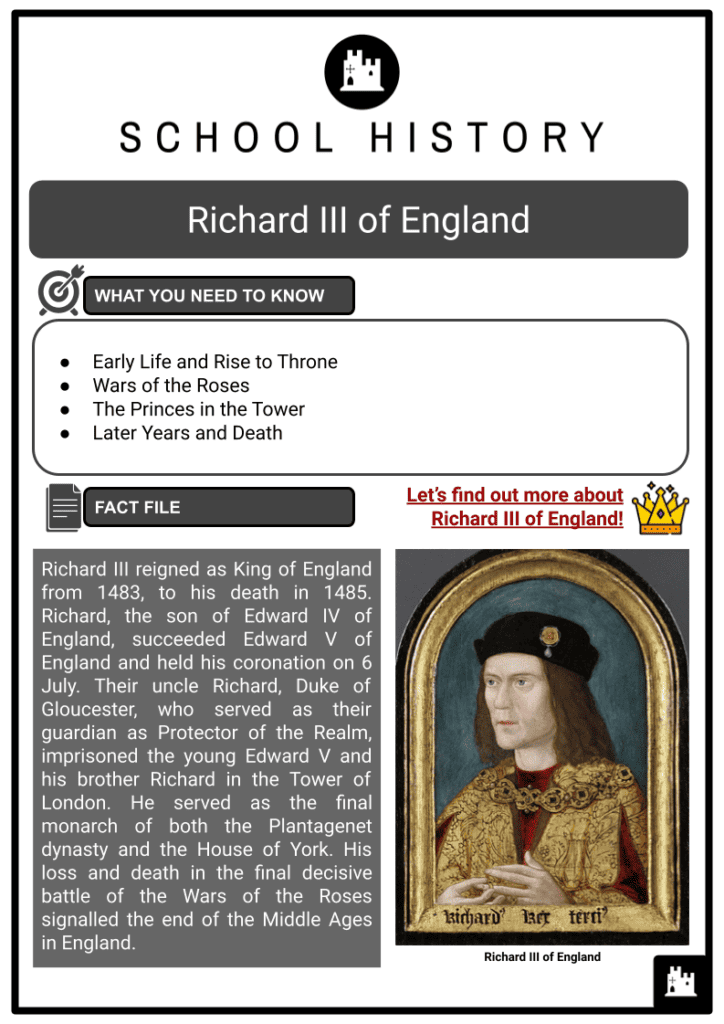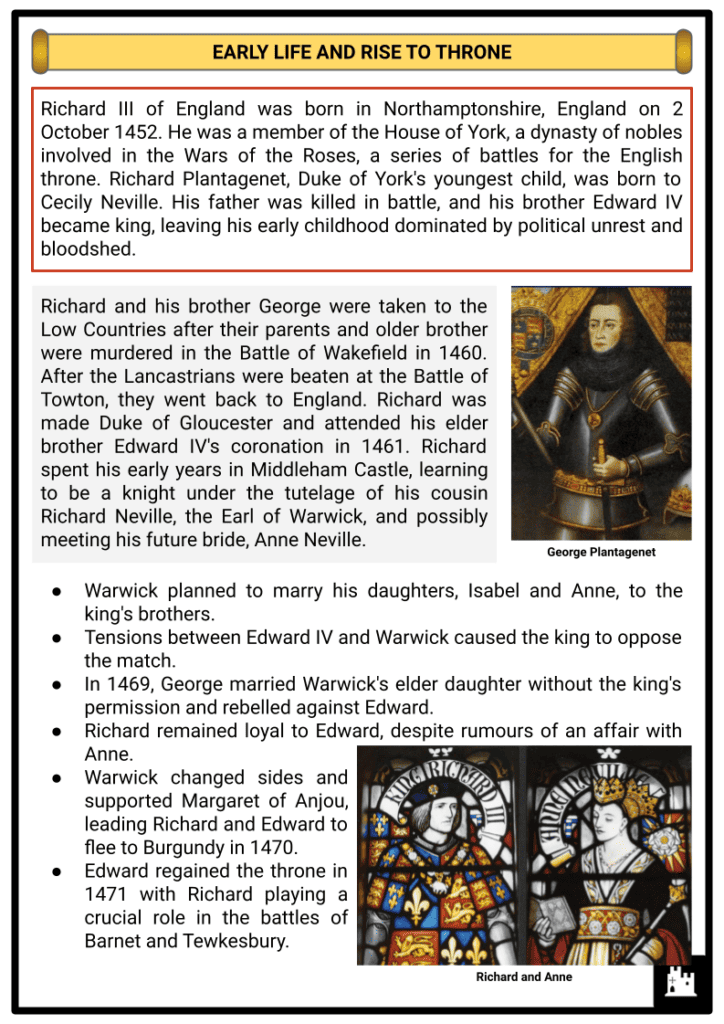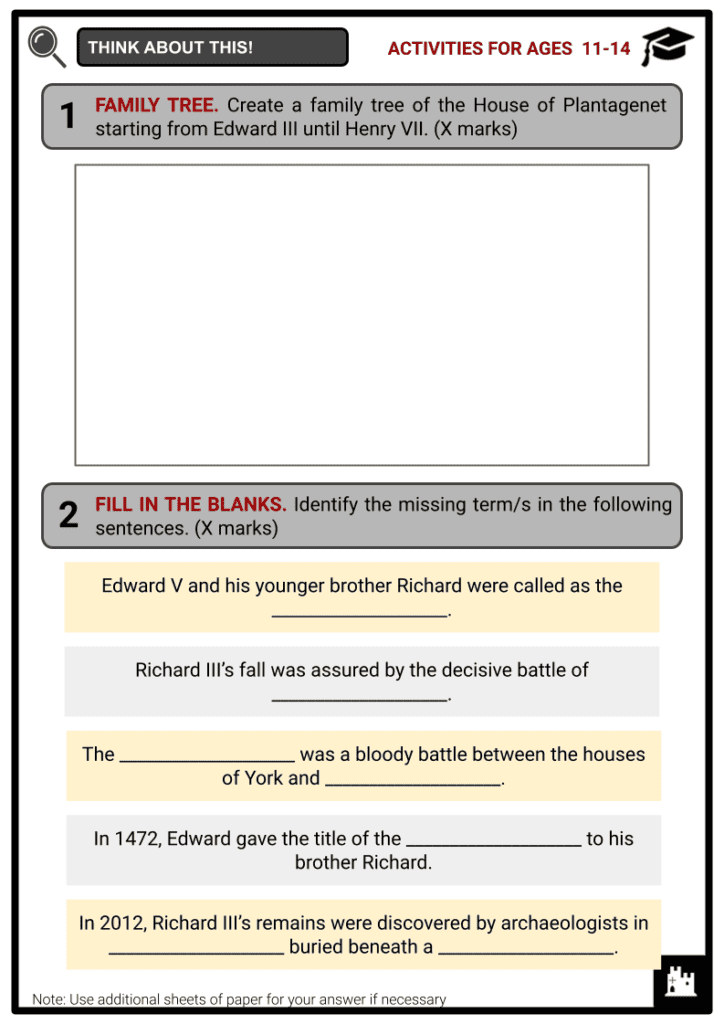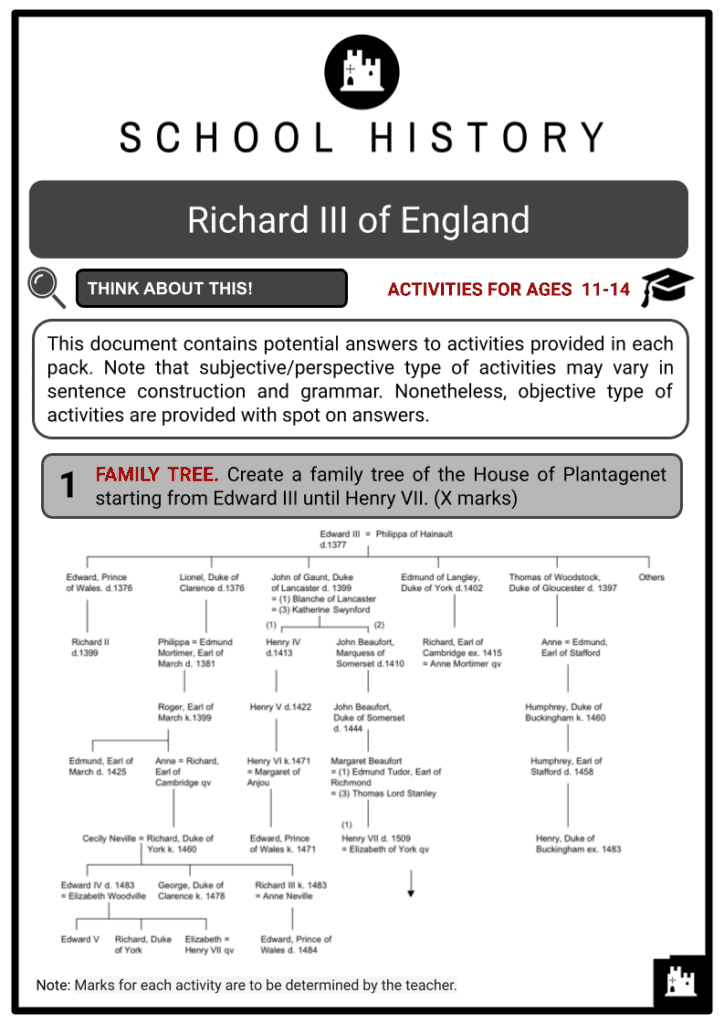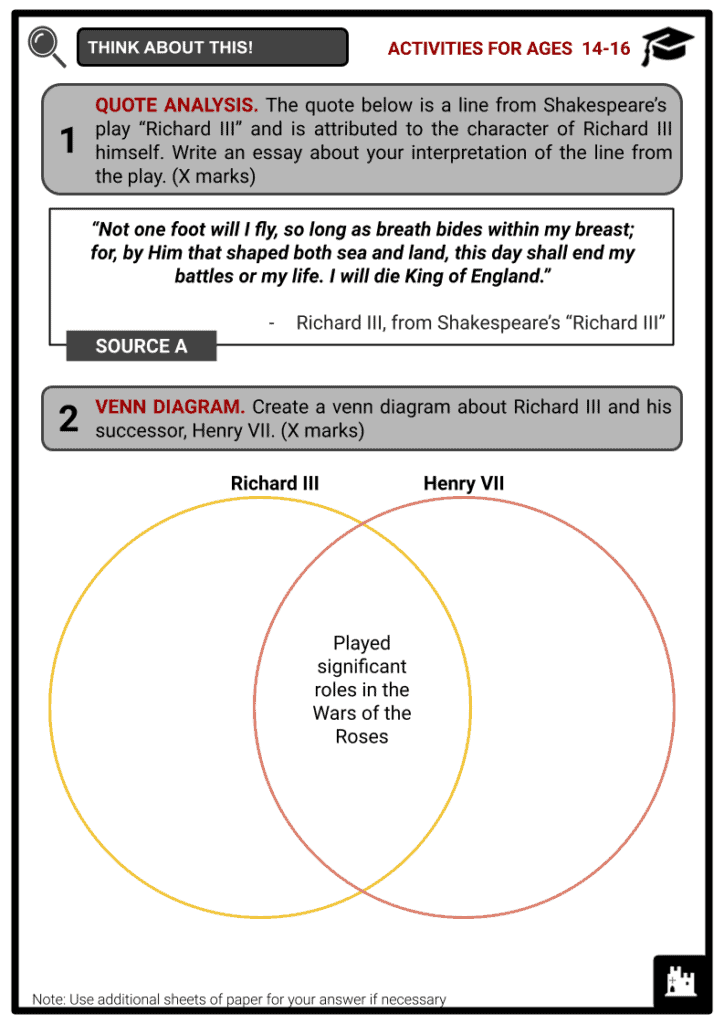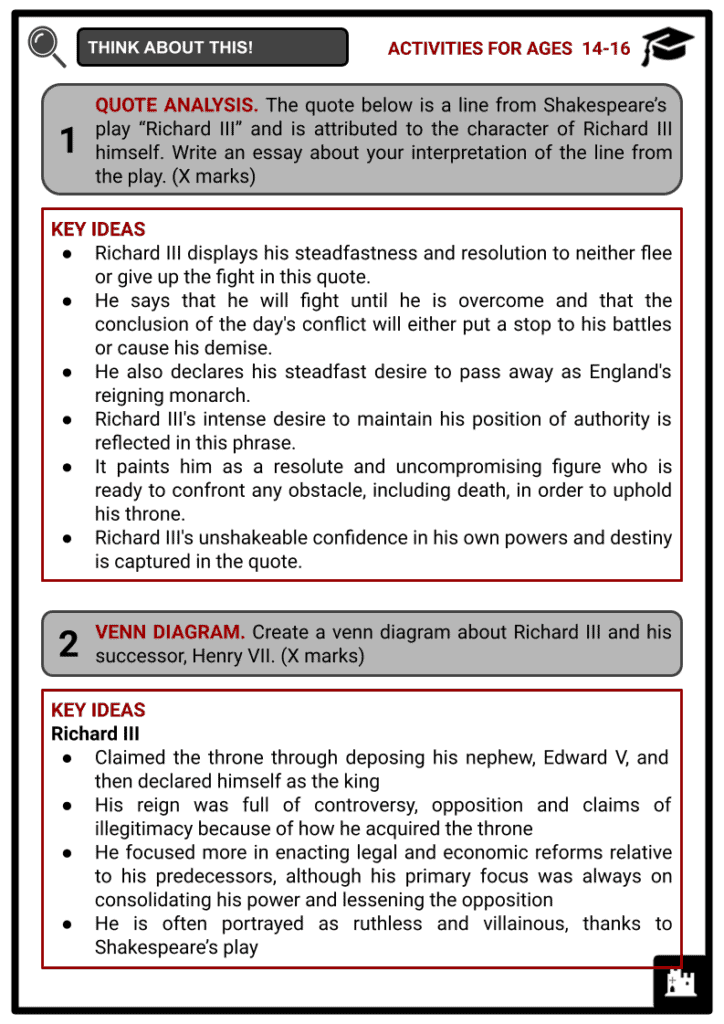Richard III of England Worksheets
Do you want to save dozens of hours in time? Get your evenings and weekends back? Be able to teach about Richard III of England to your students?
Our worksheet bundle includes a fact file and printable worksheets and student activities. Perfect for both the classroom and homeschooling!
Summary
- Early Life and Rise to Throne
- Wars of the Roses
- The Princes in the Tower
- Later Years and Death
Key Facts And Information
Let’s find out more about Richard III of England!
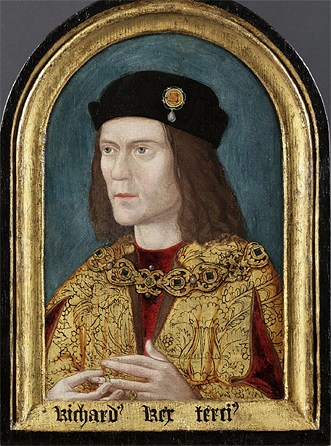
Richard III reigned as King of England from 1483, to his death in 1485. Richard, the son of Edward IV of England, succeeded Edward V of England and held his coronation on 6 July. Their uncle Richard, Duke of Gloucester, who served as their guardian as Protector of the Realm, imprisoned the young Edward V and his brother Richard in the Tower of London. He served as the final monarch of both the Plantagenet dynasty and the House of York. His loss and death in the final decisive battle of the Wars of the Roses signalled the end of the Middle Ages in England.
EARLY LIFE AND RISE TO THRONE
- Richard III of England was born in Northamptonshire, England on 2 October 1452. He was a member of the House of York, a dynasty of nobles involved in the Wars of the Roses, a series of battles for the English throne. Richard Plantagenet, Duke of York's youngest child, was born to Cecily Neville. His father was killed in battle, and his brother Edward IV became king, leaving his early childhood dominated by political unrest and bloodshed.
- Richard and his brother George were taken to the Low Countries after their parents and older brother were murdered in the Battle of Wakefield in 1460. After the Lancastrians were beaten at the Battle of Towton, they went back to England. Richard was made Duke of Gloucester and attended his elder brother Edward IV's coronation in 1461. Richard spent his early years in Middleham Castle, learning to be a knight under the tutelage of his cousin Richard Neville, the Earl of Warwick, and possibly meeting his future bride, Anne Neville.
- Warwick planned to marry his daughters, Isabel and Anne, to the king's brothers.
- Tensions between Edward IV and Warwick caused the king to oppose the match.
- In 1469, George married Warwick's elder daughter without the king's permission and rebelled against Edward.
- Richard remained loyal to Edward, despite rumours of an affair with Anne.
- Warwick changed sides and supported Margaret of Anjou, leading Richard and Edward to flee to Burgundy in 1470.
- Edward regained the throne in 1471 with Richard playing a crucial role in the battles of Barnet and Tewkesbury.
- The ascent of Richard III to the English throne was a difficult and contentious process. Richard was appointed Lord Protector for his young nephew Edward V, who was only 12 years old, after his brother Edward IV passed away. However, from his acts it seems that he had more aspirations than to be a simple regent. He took advantage of the political vacuum by deliberately positioning himself and disputing the validity of Edward IV's union with Elizabeth Woodville, alleging that their offspring were not legitimate successors to the kingdom.
- When Richard took the audacious decision to crown himself King Richard III on 26 June 1483, it astonished many people and raised suspicions of treason and malfeasance. The mystery was heightened by the sudden disappearances of the young King Edward V and his brother, known as the Princes in the Tower. Richard has frequently been blamed for their enigmatic deaths, but the reality is still hazy.
- Throughout his brief reign, Richard III encountered a lot of resistance. Richard's claim to the throne was first supported by powerful nobles like Henry Stafford, Duke of Buckingham, but they gradually turned against him. Buckingham's uprising demonstrated the shaky nature of Richard's support and revealed the growing discontent with his authority.
WARS OF THE ROSES
- Richard, Duke of York, was put forward as Protector of the Realm, effectively acting as regent, in March 1454 when Henry VI of England experienced his first episode of insanity in 1453. As the great-grandson of Edward III of England and the nephew of the Earl of March, who himself had asserted that he was the rightful successor to Richard II of England, the Duke of York had a genuine, though distant, claim to the throne. He was ambitious to become king. The Wars of the Roses were a rivalry that developed between the Houses of York and Lancaster, both of which King Henry VI belonged to.
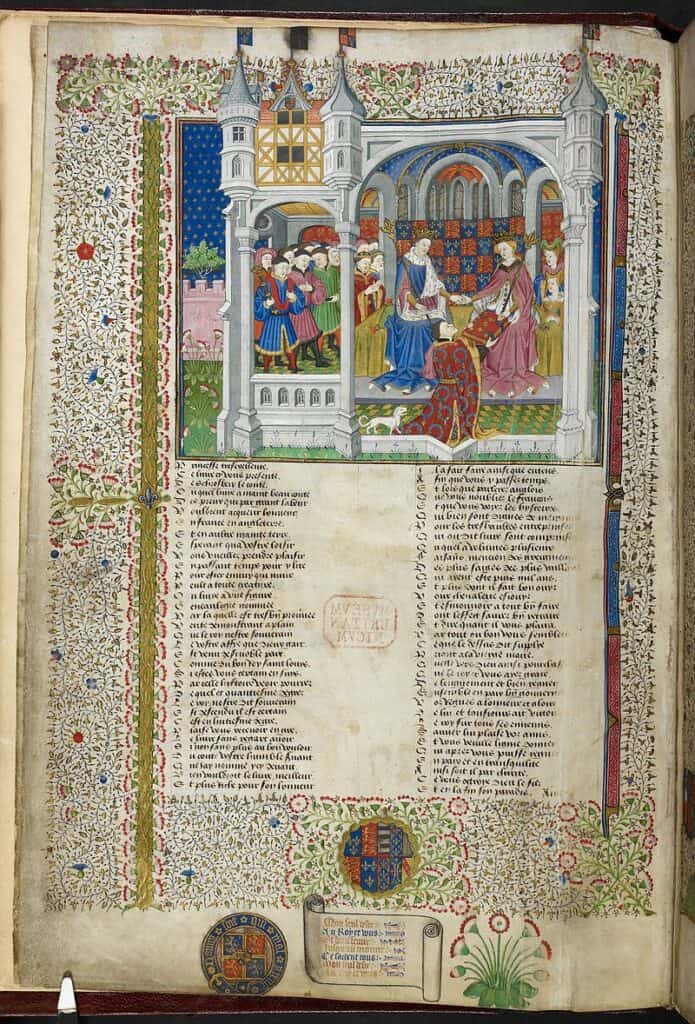
Henry VI and Margaret - Richard may have had the king in his pocket, but Henry's wife, Queen Margaret, still posed a powerful threat, and on 12 October 1459, she led an army to victory over him at the Battle of Ludford Bridge. The 'Parliament of Devils' in 1459 declared the Duke of York to be a traitor and disinherited his heirs as he fled to Ireland. The cause was soon taken up by Richard's son Edward and his main supporter Richard Neville, the Earl of Warwick. On 10 July 1460, the two defeated Queen Margaret's army at Northampton and later captured King Henry.
- Thus, the Duke of York was able to leave Ireland and convince Henry, who was now in the Tower of London, to designate him as the legitimate heir to the kingdom. This choice was confirmed by the Act of Accord on 24 October. However, Henry VI supporters were led once more by the queen at the Battle of Wakefield on 30 December 1460 CE, and they murdered the Duke of York and routed his army.
- Edward IV, son of the Duke of York, became Edward IV in 1461 after winning the Battle of Towton. He faced a temporary setback in 1470 when Henry VI was restored and he was forced into exile. However, Edward reclaimed his kingdom by winning the Battle of Barnet in 1471. Henry VI was assassinated in 1471, and the Yorks seemed to have triumphed.
- Edward appointed his brother Richard as the Duke of Gloucester in 1472, recognising his loyalty and military achievements in battles like Barnet and Tewkesbury. Richard proved himself as a capable commander and remained steadfast in support of his brother throughout the Wars of the Roses.
- Richard proved his administrative skills while managing large estates and was well-liked by his peers and subjects.
- He displayed unexpected devotion, endowing Queen's College in Cambridge for prayers to be performed for his deceased soldiers.
- Richard engaged in building projects and made donations to both government and religious organisations.
- He founded the Royal College of Arms in 1484, which now manages all aspects of mediaeval heraldic.
- Richard's personal heraldic emblem was a white boar.
- Thanks to a peace deal with France and the promotion of cross-Channel commerce, Edward IV's reign was marked by much more stability and a flourishing economy. In March 1475, when Edward and the Duke of Gloucester had led a sizable force to France, a peace contract was made with Louis XI of France. A successful expedition into Scotland in 1482 under the command of the Duke of Gloucester resulted in the temporary occupation of Edinburgh. The campaign allowed the English Crown to regain possession of Berwick.
- Rifts formed between the king, Edward IV, and his brothers in England.
- George, Duke of Clarence, the third brother, was imprisoned and executed on treason charges in February 1478.
- George's execution further discouraged Richard from pursuing peace with France.
- Richard may have believed that Elizabeth Woodville, Edward's wife, played a role in dividing the York family and favouring her own relatives.
- Richard distanced himself from the royal court in London and focused on his holdings in the north of England.
- Despite this, Edward appreciated Richard's involvement in the successful Scottish campaign.
- Richard was appointed Warden of the West March by parliament in 1483 and given sovereign authority over the region.
THE PRINCES IN THE TOWER
- As he approached middle age, Edward IV revealed to be much too fond of his favoured meals and beverages, which led to his considerable weight gain. At barely 40 years old, the monarch passed away at Westminster on 9 April 1483, possibly from a stroke. His eldest son, Edward, took over as his successor at the age of 12. Edward V, who was too young to rule alone, had previously appointed his uncle Richard as his regent. Richard was now given the prestigious title of Lord High Protector of the Realm.
- The "Princes in the Tower" were Edward V and his younger brother Richard, Duke of York, who were detained in the Tower of London in May. The guys were never seen again in front of the castle. Later, historians and Tudor propaganda claimed that Richard put the lads there and killed them.
- It was proven that the two princes did spend time in the Tower, which was not only a jail for notable individuals but a royal home, and that witnesses saw them playing in the gardens there. This is also William Shakespeare's perspective in his renowned play Richard III. It's possible that Richard imprisoned them there to thwart Queen Elizabeth's intention to crown Edward early in June. It's possible that a coronation would have resulted in Richard losing his position as Protector of the Realm and his title.
- Richard III's first tactic was to challenge the legitimacy of the two princes, Edward V and his younger brother, by claiming that their father, Edward IV, had already been contractually bound to marry Lady Eleanor Butler before his marriage to Elizabeth Woodville.
- Richard used the well-known promiscuity of Edward IV to cast doubt on the legitimacy of his children. Parliament subsequently declared the princes illegitimate.
- Richard III was implicated in their murder because he had been present in the Tower on the night that Henry VI was killed and was believed to be involved in other nefarious activities to advance his position. In the late summer of 1483, Edward V and his younger brother mysteriously disappeared from the Tower of London. The reason for the princes' deaths, however, is still unknown.
- Two young men's skeletons were found in 1674 and recognised as the princes when they were unearthed during the demolition of a nearby forebuilding. After a study in 1933 determined that the remains belonged to young lads their age, they were re-interred in Westminster Abbey. Edward V became the unlucky 13th king in the Plantagenet dynasty despite the fact that the identity of their murderer is still unknown. Richard poised to benefit the most from their murders.
LATER YEARS AND DEATH
- Richard III implemented various measures to cement his rule, bolstering his power and gaining the nobility's support. In addition to putting policies into place to increase the effectiveness and fairness of the judicial system, he formed a council to aid in governance. His goal was to improve his reputation as a just and effective leader by implementing these progressive judicial changes.
- Richard III encountered persistent opposition, nonetheless, despite his best attempts to establish his rule. An important threat came from Henry Tudor, the exiled Lancastrian pretender to the throne. With the assistance of disgruntled Yorkist and Lancastrian nobility as well as French mercenaries, Henry Tudor returned to England in 1485. As they advanced towards Richard III, their united troops gained additional allies.
- Richard III's demise was assured by the decisive Battle of Bosworth Field, fought on 22 August 1485. Richard was a brave and capable military commander, but Henry Tudor's greater army overpowered and routed Richard's troops. In the midst of the conflict, Richard III charged towards Henry Tudor in an audacious and desperate attempt to kill or seize him and put an end to the uprising all at once. Richard, however, discovered himself stranded and encircled by hostile soldiers.
- Richard III died tragically in this tumultuous situation. He was killed in combat after being struck in the head, possibly with a poleaxe. The Wars of the Roses, a protracted and bloody battle between the houses of York and Lancaster, came to an end with his passing, and Henry Tudor's accession to the throne as King Henry VII marked the start of the Tudor dynasty.
- After being de-armoured and shown in Leicester, Richard III's body was unceremoniously interred in Greyfriars Church. The precise site of his tomb was forgotten and lost over time. But in 2012, archaeologists in Leicester made a startling discovery when they found Richard III's remains buried beneath a parking lot. The following examination of his skeletal remains revealed further information about his features, notably the spinal curvature that was consistent with historical reports and gave rise to the nickname "the hunchback king."
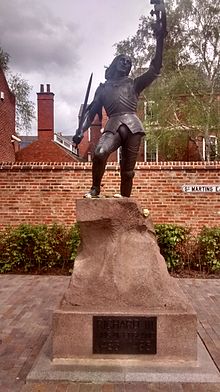
Statue of Richard III outside Leicester Cathedral - Richard III's rediscovery and reinterment in Leicester Cathedral in 2015 generated a resurgence of interest in his life and reign. His character, accomplishments, and the degree of his engagement in the events that took place during his reign are still up for dispute among academics and enthusiasts. With its intrigue, controversy, and terrible end on the field of Bosworth, Richard III's life continues to be a fascinating chapter in English history.
- Richard III's historical legacy remains a subject of debate and contention.
- Some view him as a usurper and villain, while others argue he was a capable leader.
- During his reign, Richard III implemented legal reforms and prioritised improving the justice system.
- Economic stability was emphasised under Richard III's rule.
- His reign is associated with the transition from the mediaeval era to the early modern era in England.
- Richard III's life and reign continue to intrigue historians and enthusiasts.
- Ongoing discussions and debates persist regarding the true significance of his historical legacy.
Image Sources
- https://en.wikipedia.org/wiki/Richard_III_of_England#/media/File:Richard_III_earliest_surviving_portrait.jpg
- https://en.wikipedia.org/wiki/Talbot_Shrewsbury_Book#/media/File:Presentation_page_Talbot_Shrewsbury_Book.jpeg
- https://en.wikipedia.org/wiki/Richard_III_of_England#/media/File:Pomnik_Ryszarda_III_przy_Katedrze_%C5%9Aw._Marcina_w_Leicesterze.jpg

